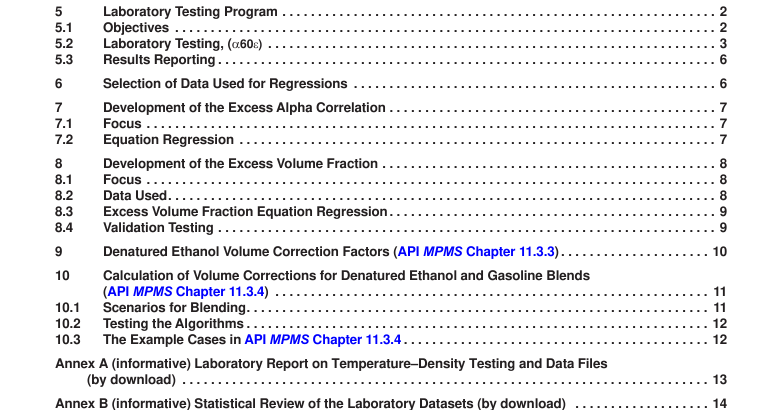API TR 2580:2019 pdf free download.Miscellaneous Hydrocarbon Product Properties— Denatured Ethanol Density and Volume Correction Factors
5Laboratory Testing Program5.1Objectives
The volumetric properties of gasolines are well-characterized by API MPMS Chapter 11.1 which is widely acceptedby industry. This standard is also implemented in thousands of computing systems.An objective of the program wasto create a process for density and volume correction for ethanol blended fuels that could be implemented within thecontext of API MPMs Chapter 11.1 applications preferably without changing the API MPMs Chapter 11.1methodologies.
The temperature-density behavior of denatured ethanol needed to be established and a standard procedure forcalculating standard volumes published.Various sources of this information existed, predominately for pure ethanol,on different bases and with different levels of documentation.
A testing protocol was developed that would gather sufficient information on various denatured ethanolBOB blendsso that the necessary thermal expansion coefficients for API MPMS Chapter 11.1 could be calculated. Additionaltesting was performed to determine how long a mixture required to reach a stable density.
5.2Laboratory Testing, (c6oE)
The density-temperature behavior of denatured ethanol-gasoline blends was evaluated in a laboratory testingprogram conducted under contract with APl.These data were intended to be used to implement an accurate thermalexpansion coefficient, a, within the existing API MPMS Chapter 11.1.
Four denatured ethanol samples were used, identified as F1,F2,F3, and F4, provided by the Renewable FuelsAssociation:
一FS1: 2 % natural gasoline by volume to 98 % fuel ethanol
一FS2:5 % natural gasoline by volume to 95 % fuel ethanol
一FS3: 2 % gasoline by volume to 98 % fuel ethanol
一FS4: 5 % gasoline by volume to 95 % fuel ethanol
The BOB gasoline samples used were donated by one of the project sponsors and identified as FS5,FS6,FS7, andFS8.The different samples covered a range of densities, aromatic and saturate compositions,and Reid vaporpressures (RVPs).Detailed analyses of the BOB samples are included in the Annex A subfolder entitled“”A.5Section 7 Ethanol Gasoline Feedstock”.
Individual blend samples are identified throughout the studies as some combination of the feedstock identifiers andthe concentration of the denatured ethanol volume percent. As discussed below,the individual test runs werenumbered and the results of all the tests on a single blend were also combined into datasets that were assignednumbers. Though these ID schemes were internally consistent within a single researcher, the user wil find it easier tofollow the suggestion above.
The laboratory program was extended to include additional concentration-temperature pairs and testing continued inphases from 2008 through 2013.In 2011, testing of 15 % and 35 % blends as well as retesting of the gasoline blendstock bases was authorized. Table 1 shows the range of testing data developed for the project.
There was a volume growth (density decrease) that occurred when blending denatured ethanol and gasoline blend stock. This effect is consistent with observations of “excess molar volume” reported in the literature for specific hydrocarbon and polar molecule mixtures.
The alphas and volume growth calculated from the laboratory program data showed a sensitivity to the concentration of ethanol in the blend and led to later analysis phases of the overall project. As was expected, an “alpha” equation derived from the testing of BGE blends was required to accommodate the volume growth. When used with the alpha and excess volume equations developed in this effort, individual blends followed the API MPMS Chapter 11.1 expansion equation well, showing the continued utility of API MPMS Chapter 11.1.
There were some delays and testing issues, extending the testing over a period of time and some of the blend samples appear to have suffered from a loss of some of the lighter components of the mixtures. This shift in some of the samples was detected after some of the testing was completed and was addressed in later data analysis as discussed in 5.3.
5.3 Results Reporting The testing conducted by the laboratory is documented in a report in Annex A. The report itself contains mostly procedural and organizational information. The supporting data in that report is referred to as “See USB drive”. Those files provided by the laboratory are included in a folder within Annex A. Review of data, culling and data organization produced the consolidated data set which was the primary data source for the analysis and is found in Annex C.API TR 2580 pdf download.API TR 2580:2019 pdf free download
